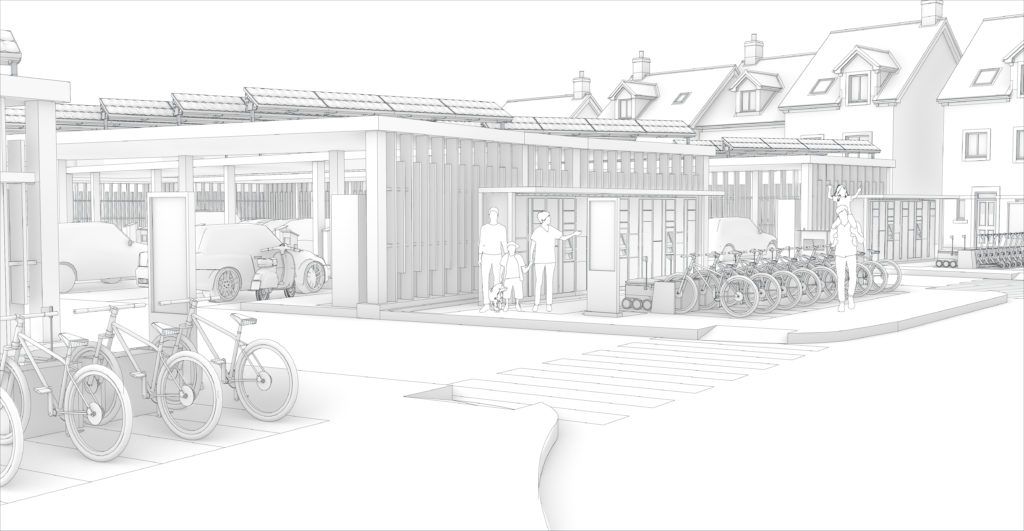A radical ‘Vehicle to Community’ (V2C) concept which harnesses the untapped energy from stationary electric vehicles (EVs) while creating greener, healthier more sustainable residential spaces is being explored by Stantec.
The company is working with net zero data analytics consultancy, Field Dynamics, multi-utility network operator mua, and leading EV smart charging tech business, Indra, in developing its transformative V2C proposition which has the potential to reinvent street design across the UK.
The V2C concept has been developed in response to key challenges facing Britain including the current energy market crunch, the national journey towards a net-zero economy, healthier living and the widespread growth of the electric vehicle (EV) sector.
V2C reimagines residential development car parking, creating a centralised, accessible community asset, rather than having traditional on-plot parking. This central, managed car park is over 30% more efficient than conventional designs and would be able to utilise the normally unproductive energy stored in idle electric vehicles.
A development designed with V2C reduces the need for driveway construction, saving significant levels of embedded carbon. With no need for vehicles to park on plots, streets would be reduced in size and made to be more natural, providing access only to pedestrians, cycles and service or emergency vehicles.
The proposition also offers a host of wider benefits to new communities and can be applied to existing ones. As well as significantly cutting energy bills for homeowners through its own microgrid, the concept could substantially reduce ‘urban heat island’ effects by allowing for greater landscaping, more trees and pergola green roofs and reduced hard surfaces. For developers, a V2C design would allow for more biodiversity net gain areas, and more surface water attenuation, freeing up space elsewhere on site for additional benefits like community solar PV, and potentially increasing plot count by 10-20%. The innovative energy system would measurably reduce grid demand as well as the need for new power infrastructure.
At the same time, there would be a greater opportunity to integrate sustainable mobility hubs including bike-share, car-share, and delivery lockers which are easily accessible. With more open, greener spaces, and less vehicles on plots, resident wellbeing is enhanced and a more active lifestyle, encouraged. It is thought that the scheme would also, in the long-term, promote shared mobility and low-carbon transport modes.
Jason Lewis, Director, Transport Planning at Stantec, commented: “We started this project through a desire to meet the market’s biggest challenges head on by bringing together colleagues from the development, EV charging and power industries. Together, we were able to explore new ways of using existing technologies in a smarter approach to allow communities to embrace nature while delivering opportunities to meet net zero and energy targets.
“We always seek to challenge outdated thinking and turn traditional urban design ethos on its head, while ensuring feasibility and deliverability to meet the needs of developers, their customers and stakeholders in an increasingly climate-conscious world.”
Leighton King, Indra’s Chief Commercial Officer said: “We’re delighted to support Stantec’s innovative concept to create a Vehicle to Community power microgrid. Most cars are idle for 95% of the time and Indra’s bidirectional charging technology turns them into active power units.
“Installing our state-of-the-art bidirectional chargers to centralised parking areas will significantly reduce grid demand and help our journey to net zero. A sustainable mobility hub will be a valuable asset to all communities in the future.”
Charlie Gilbert, Partner at Field Dynamics said: “We’re really excited to be working on this project with Stantec, Indra Technologies, and mua to support innovative sustainable developments. Our data driven approach will help assess site viability, energy consumption and generation through our hyper-granular data modelling capability.”
Ben Croxford, Business Development and Strategy Lead at mua, added: “V2C is a truly transformational concept, which absolutely aligns with our desire to help build better and more sustainable places to live and work. By offering flexible and innovative design solutions, we can build new electricity networks capable of harnessing untapped greener energy. We’re proud to be part of such an innovative partnership that can help the UK’s transition to net zero.”
Image courtesy of Stantec.








